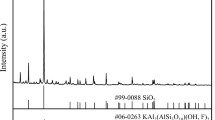Abstract
In situ leaching of uranium by aqueous ammonium carbonate containing oxygen or hydrogen peroxide as oxidant results in the partial dissolution of sulfides. While some of the sulfide sulfur is oxidized to sulfate, a considerable portion is oxidized only to thiosulfate and polythionates. Polythionates poison the ion exchange resin used to extract uranium. At the Palangana operation in south Texas, the trithionate ion (S3O62−) was found by infrared spectrometry to be the major resin poison. Treatment of ion exchange feed solutions with hydrogen peroxide only resulted in partial conversion of reduced sulfur species to sulfate. Trithionate conversion was particularly slow. Poisoning of the resin also occurred from the ammonium chloride eluant, which built up trithionate because of recycling. This was essentially eliminated by chlorinating the eluant before yellow cake precipitation.
Similar content being viewed by others
References
Annamalai, V., and McGarvey, F.X., 1980, “Operating Experience in the Recovery of Uranium at the Pawnee and Zamzow Sites,” 55th Annual Fall Technical Conference and Exhibition, SME-AIME, Dallas, TX, September, 17 pp.
Berry, V.K., and Annamalai, V., 1981, “Analysis of Ion Exchange Resin Used In Uranium Solution Mining: an SEM EDS Study,” Microbeam Analysis, Vol. 16, pp. 171–173.
Dowson, W.M., and Jones, W.F., 1974, “Studies in Qualitative Inorganic Analysis, Part XLIII. The Alkali Metal Salts of the Sulfur Oxy-Acids,” Mikrochimica Acta, No. 2, pp. 339–368.
Goddard, J.B., and Brosnahan, D.R., 1982, “Rate of Consumption of Dissolved Oxygen During Ammonium Carbonate In-Situ Leaching of Uranium,” Mining Engineering, Vol. 34, No. 11, November, pp. 1589–1596.
Granger, H.C., and Warren, C.G., 1969, “Unstable Sulfur Compounds and the Origin of Roll-Type Uranium Deposits,” Economic Geology, Vol. 64, No. 2, pp. 160–171.
Hofman-Bang, N., and Christiansen, M.T., 1961, “Titration of Polythionates by Means of a Standard Sodium Hypochlorite Solution,” Acta Chemica Scandinavica, Vol. 15, No. 10, p. 2061.
Kurtenacker, A., and Goldbach, E., 1927, “Analysis of Polythionate Solutions,” Zeitschrift fur Anorganische und Allgemeine Chemie, Vol. 166, No. 1–3, pp. 177–189.
Litz, L.M., 1982, “In-Situ Uranium Mining With Oxygen,” Mining Engineering, Vol. 34, No. 1, January, pp. 52–56.
Lunenok-Burmakina, V.A., and Gersenkova, A.N., 1964, “Mechanism of the Oxidation of Inorganic Sulfur Compounds by Hydrogen Peroxide,” Russian Journal of Inorganic Chemistry, Vol. 9, No. 2, February, pp. 149–152.
Lyons, D., and Nickless, G., 1968, “The Lower Oxy-Acids of Sulfur,” Inorganic Sulfur Chemistry, Elsevier, New York, NY, pp. 509–533.
Naito, K., Hayata, H., and Mochizuki, M., 1975, “The Reactions of Polythionates, Kinetics of the Cleavage of Trithionate Ion in Aqueous Solutions,” Journal of Inorganic and Nuclear Chemistry, Vol. 37, No. 6, June, pp. 1453–1457.
Naito, K., Shieh, M., and Okabe, T., 1970, “The Chemical Behavior of Low Valence Sulfur Compounds. V. Decomposition and Oxidation of Tetrathionate in Aqueous Ammonia Solution,” Bulletin of the Chemical Society of Japan, Vol. 43, No. 5, May, pp. 1372–1376.
Nugent, E.A., 1957, “The Chemistry of the Poisons Associated with the Ion Exchange Process,” Uranium in South Africa, 1946–1956, Vol. 2, Associated Scientific & Technical Societies of South Africa, Johannesburg, pp. 177–191.
Stamm, H., Goehring, M., and Feldman, U., 1942, “Polythionic Acids and Their Formation, VI. New Methods for the Preparation of K2S3O6 and K2S4O6,” Zeitschrift fur Anorganische und Allgemeine Chemie, Vol. 250, pp. 226–228.
Stamm, H., Seipold, O., and Goehring, M., 1941, “Polythionic Acids and Their Formation, IV. The Reactions Between Polythionic Acids and Sulfurous Acid or Thiosulfuric Acid,” Zeitschrift fur Anorganische und Allgemeine Chemie, Vol. 247, pp. 277–306.
Vodolazov, L.I., Laskorin, B.N., Loshmanova, E.M., and Rodinov, V.V., 1976, “Accumulation of Polythionates, Elemental Sulfur, Thiocyanates, and Cyanides in Ion-Exchangers,” Journal of Applied Chemistry of the USSR, Vol. 49, No. 5, May, pp. 1033–1036.
Author information
Authors and Affiliations
Additional information
SME preprint 84-10, SME-AIME Annual Meeting, Los Angeles, CA, March 1984. MMP paper 84-605. Manuscript December 1983. Discussion of this paper must be submitted, in duplicate, prior to July 31, 1985.
Rights and permissions
About this article
Cite this article
Goddard, J.B. Uranium In Situ Leaching Sulfur Chemistry. Mining, Metallurgy & Exploration 2, 120–127 (1985). https://doi.org/10.1007/BF03402607
Published:
Issue Date:
DOI: https://doi.org/10.1007/BF03402607




